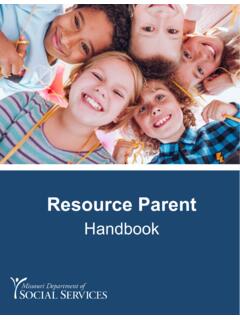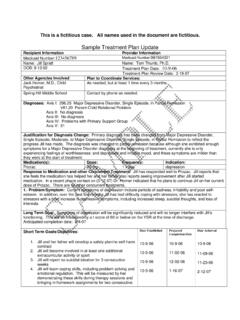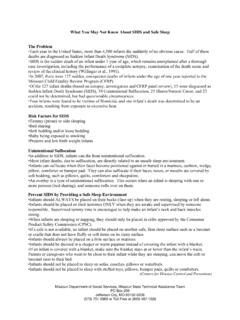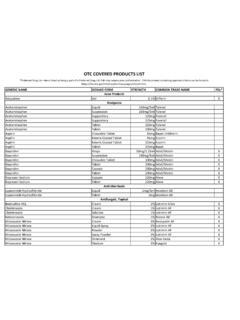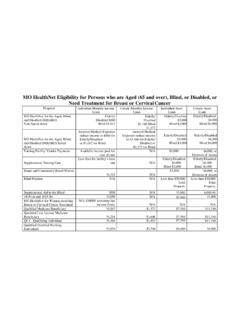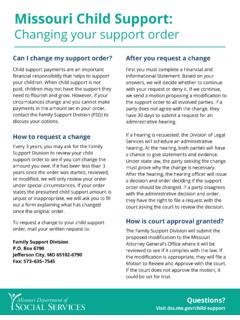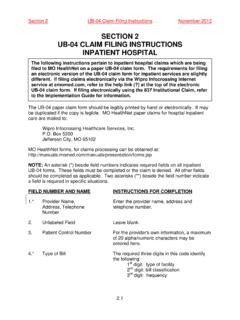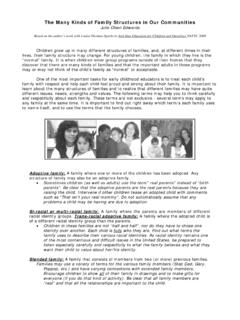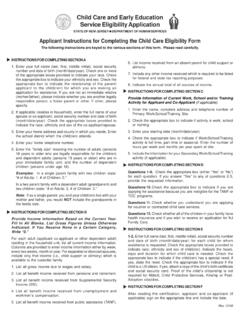Transcription of Respite Care Provider Handbook - dss.mo.gov
1 1 Respite care Provider Resource Handbook 2 Table of Contents Introduction .. 03 What is Respite care ? .. 04 Is Respite care Right for You? .. 05 Getting Started .. 06 Types of Respite care .. 07 Youth with Elevated Needs .. 08 Communication & Relationships .. 10 Payment .. 11 Adverse Childhood Experiences (ACEs) .. 12 Attachment and Trauma .. 13 Attachment .. 14 Trauma .. 15 Behavioral Management .. 16 Tackling Transitions .. 17 Your Role .. 18 Additional Resources .. 19 Knowledge Assessment .. 20 3 Introduction Respite care is an important part of the foster, adoptive, or kinship care experience. It offers resource parents a short period away, which ultimately gives them and the children in their home time apart to rest and recharge.
2 To help families feel more comfortable using Respite care , we must first help you develop the skills you need to provide quality care . In this Handbook , you will find a preview of the responsibilities required of Respite care providers. You will also find tactics and resources that might be helpful to you. Ultimately, our goal is to help Respite care providers: Develop trust with families and the Respite program agency Build relationships and communication between providers and families Keep the best interest of the child in mind at all times Understand the needs of the children who will be using Respite services care for children with a variety of special needs Manage expectations about the role of a Respite care Provider Review resources that could help you on your journey 4 What is Respite care ?
3 To put it simply, Respite care allows one family to temporarily care for another family s foster child or child they have adopted. Respite care gives foster, adoptive, and relative ( kinship ) families an opportunity to take a break and reduce stress from ongoing responsibilities, take care of an emergency, or tend to other personal needs. Respite care should not be confused with day care or babysitting, and it is not meant to be used for things like work or an evening out. Asking for help through Respite care is not a negative thing and it does not mean the family does not love the child in their care . In fact, Respite care should be viewed positively and encouraged, as it reduces stress, family tensions, depression or isolation, disruptions/dissolutions, and the risk of abuse or neglect.
4 Respite care ultimately increases the family s ability to cope and successfully parent their child. In addition to helping resource parents, Respite care provides the child an opportunity to develop healthy relationships with others, build their self-esteem and social skills, and learn to trust other adults. This should be a fun and rewarding time for the child and should offer them opportunities to take part in social and enrichment activities and help them build a community of advocates and peers within the foster care community. 5 Is Respite care Right for You? Respite care providers will need to be patient, flexible with their time and availability, and have extremely effective communication skills, especially with parents and resource providers.
5 Before deciding to become a Respite Provider , we encourage you to ask yourself if you are you willing and able to: Complete the screening and training requirements Protect and nurture children Work as a member of a professional team Follow rules and guidelines Cooperate with Children s Division or private agency staff Demonstrate positive and effective parenting skills Understand loss, grief, and attachment issues Meet the developmental needs of the children Help with unexpected emotional, medical, and/or behavioral problems in children If you consider yourself to have these qualities, you might be a good candidate for providing Respite care .
6 NOTE: Respite care applicants are also carefully screened about their motivations for providing Respite . 6 Getting Started There are numerous steps involved in becoming a Respite care Provider , and it might be overwhelming at first. However, child safety is our number one priority, and these steps help us ensure our standards of care and child safety are being met. Keep in mind that you will have a resource worker to support you in this process. To be approved as a Respite care Provider , you must be at least 21 years old (single or married) and you must complete the required background screenings and training. This training will help you develop the skills, resources, and education you need to provide quality care and comfort to families when they leave their child in your care .
7 Although the training might seem like a big time commitment, we do it because we want you to have the tools to do your job well and help you reap the rewards that come with it. All Respite care providers will be required to meet the same requirements as foster parents as set forth in the CSR Physical Standards for Foster Homes. Therefore, if you will be providing Respite care in your home, we will visit your home to make sure it is safe for a child and to determine how many children can be in the home at one time. We will also go over the following forms with you and get any signatures required: Application to Provide Respite care (CS-RC-1) Respite care Provider Approval (CS-RC-3) Cooperative Agreement for the Purchase of Respite care Services (CM-10) Resource Parent Discipline Agreement (CD-119) Safe Sleep Practices (CD-117) Foster Respite care Provider Checklist (CS-RC-2) Respite care Provider Training NOTE.
8 These E-forms can also be found at You will also be required to complete and pass the following background screenings as set forth in 13 CSR Family Homes Offering Foster care and the Child Welfare Manual Section Fingerprint-based criminal background check (13 CSR ) Child Abuse and Neglect Registry check Missouri Family care Safety Registry check (13 CSR ) Sex Offender Registry check search Confidentiality Notice: All information that you learn about the child, their birth/first families, or adoptive and kinship families is considered confidential and must not be shared with others 7 Types of Respite care Respite care can vary in type and length depending on what the resource parent needs.
9 For example, if a resource parent is attending a funeral in another state, they may need several days of Respite care . Other needs might include illness, hospitalization, or potentially stabilizing the placement when issues arise at home. Traditional & Untraditional Respite care Respite care can be provided either at the resource Provider s home (in-home) or at your home (out-of-home). This type of Respite care is called traditional Respite care . The Central Missouri Foster care & Adoption Association (CMFCAA) also offers untraditional Respite care , which typically involves monthly partnerships with a local business like the YMCA or The Activities & Recreation Center (ARC).
10 These are themed events that provide Respite to kinship /relative, foster, and adoptive children. You can find the event details and sign up for these Respite events through the calendar. These events are offered on a first-come, first-served basis. Scheduling Respite care providers have full control over their schedule. You will be able to decide whether a placement works for you each time you are contacted. Resource parents in need of Respite care will call their Licensing Worker or their Case Manager and provide the child s details and when the care is needed. They are then matched with Respite care providers based on their needs and skill levels.
